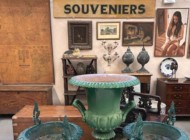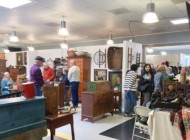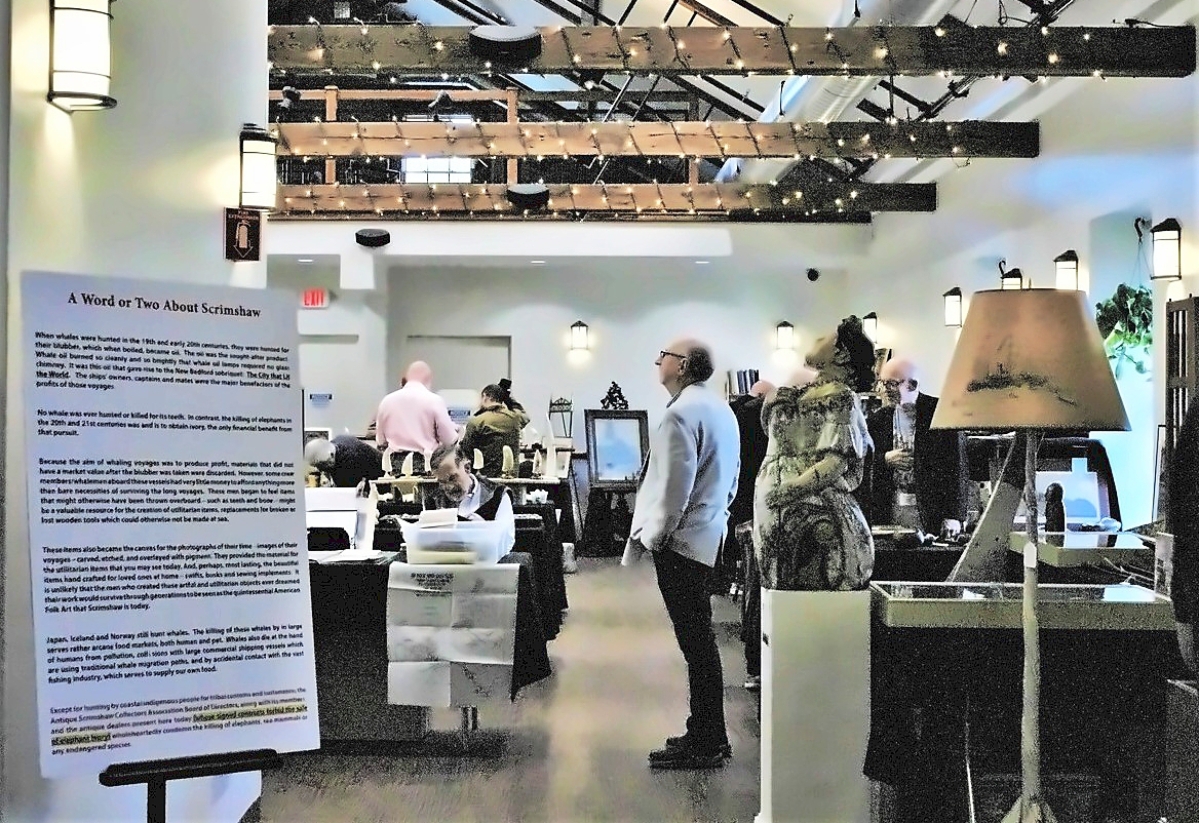
The entry to the Nautical Antiques Show on September 23.
Review & Photos by Z.G. Burnett
NEW BEDFORD, MASS. – The Antique Scrimshaw Collectors Association hosted its 32nd Annual Scrimshaw & Nautical Antiques Weekend September 23-25, returning with great success after a three-year hiatus. Presented by the Antique Scrimshaw Collectors Association (ASCA), the weekend included the 11th Annual Nautical Antiques Show, seminars, an evening banquet and a field trip to the Cahoon Museum of Art. The weekend was sponsored by Eldred’s and Bad Martha Farmer’s Brewery in Falmouth, Mass., where the group lunched on Sunday. According to event organizer Mary Boger, the weekend went well, “We were very happy with our attendance numbers, especially as it has been three years since our last Scrimshaw Weekend.”
The show was a true “who’s who” and “what’s what” of scrimshaw and maritime antiques, hosted at the Marriot Hotel/Fairfield Inn & Suites’ Waypoint Event Center, overlooking New Bedford’s historic pier. It was more quality than quantity, as the treasures that were offered by less than 20 dealers would have elevated any collection. Antique and modern scrimshaw covered the booths of some tables while others were decorated like a wealthy captain’s quarters, still more took on the look of a cabinet of curiosities with ancient artifacts and other natural specimens. The reception hall was crowded with attendees, buying and trading with each other like merchants of old.
Guests were greeted with a nametag lanyard and the booth of John F. Rinaldi, presided over by a large and elaborate scrimshaw clock tower from the Nineteenth Century. Rinaldi has been specializing in marine antiques since 1972. Made from teak wood that was trimmed and inset with whalebone and tortoiseshell, the tower’s upper portion was pierce carved with a crest in the shape of an American eagle. The tower was from the personal collection of Rinaldi and priced at $22,500. Also in Rinaldi’s booth was a lamp made with a 69-inch narwhal tusk and three 16-inch walrus tusks, descended in the family of Admiral Robert E. Peary (American, 1856-1920), who is known for leading one of the first exhibitions to the geographic North Pole in 1909. The lamp’s documented provenance and excellent condition warranted the price tag of $27,500. Another of his offerings was a large mahogany tiller from the Nineteenth Century, painstakingly carved with a braided rope motif throughout and a stylized dolphin on one end. Boger commented, “That’s the most beautiful tiller I’ve ever seen.” Instead of being preserved as a presentation piece, Rinaldi believed that the tiller had been used for a yacht and had priced it at $6,500.
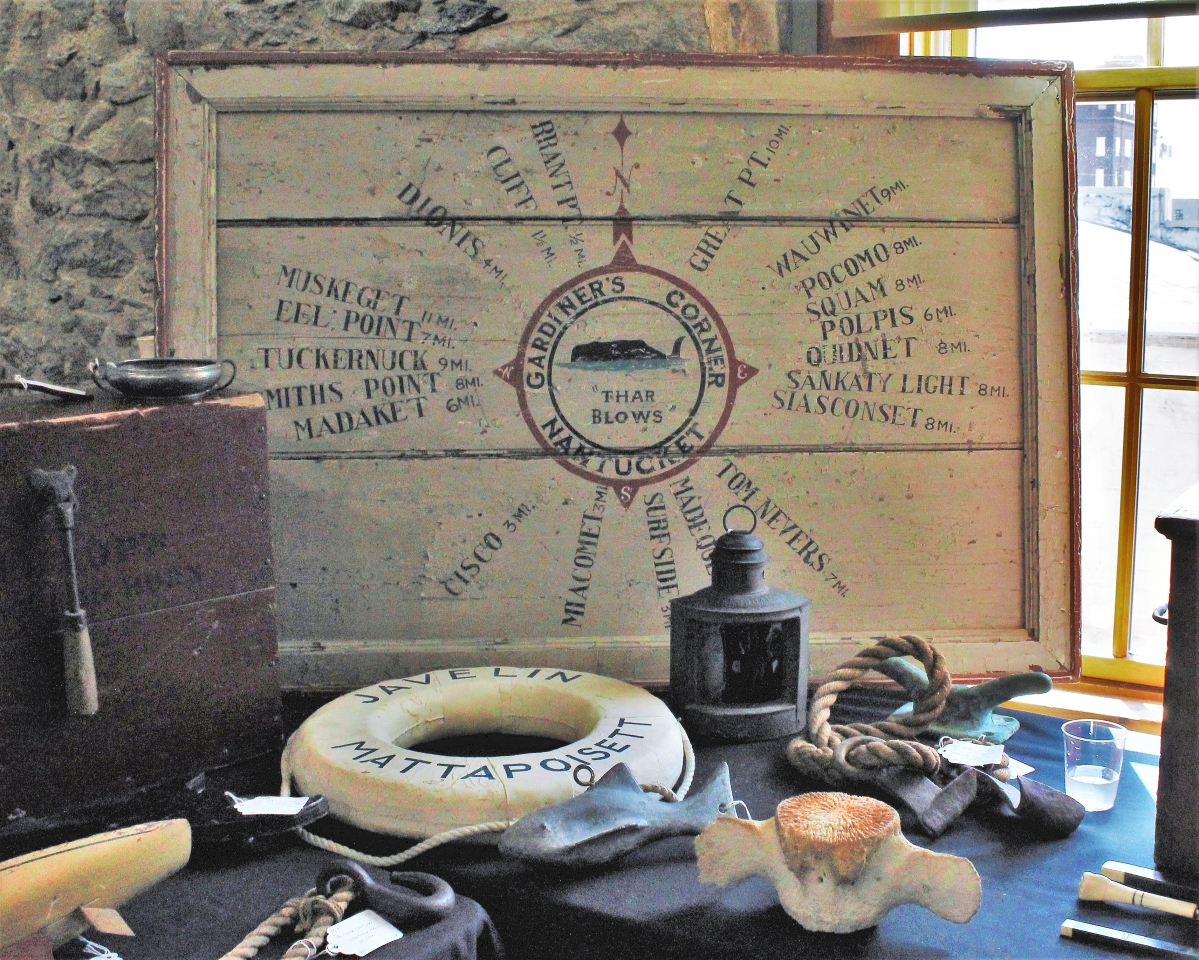
Mark Jacobson’s booth, shared with Paul and Parke Madden, was decorated with this attractively patinated recreation of the city sign at Gardiner’s Corner on Nantucket; it was offered for $1,500.
The next booth belonged to Ryan M. Cooper, who has been dealing for 40 years and showed with the ASCA “since the beginning.” Cooper began dealing maritime antiques in California before he moved to New England, and now works out of Yarmouth Port, Mass. He shared the space with a figurehead from the schooner Minnie, offered at $27,500. The Minnie was built at Peter Head, Scotland, and launched in 1878. She sailed until 1938. This was one of the first figureheads acquired by the Mystic Seaport Museum in 1939 and was deaccessioned in 2020. The figurehead retained much of its original paint as well as its provenance. When we arrived, Cooper and Mark Jacobson were inspecting the tip of one of the many harpoons stocked in his booth. He is on the ASCA board and presented the “Wooden Figureheads & Ship Carvings” seminar the next day.
Across the aisle, Gregory Gibson of the Ten Pound Island Book Company (Gloucester, Mass.) was seated among his wares. Open books and manuscripts covered his tables, varying in age and price, all focused on the history of sailing and some that were artifacts of seafaring, themselves. Many of these were the personal logs of sailors, either journals or ledgers, that documented their day-to-day activities and accounts. Commercial fishing logs were discarded far more frequently than whaling logs, adding to the richness of Gibson’s stock. One of these belonged to Samuel S. Inglee, who rendered specific details and ship names of his 1855 voyages, including several pages of his own poetry. The journal had a hand-stitched canvas cover with a newsprint clipping of “The Yankee Privateer,” and was offered for $1,250. This was Gibson’s seventh year with the show and he was already happy with his sales at the beginning of the day. “They’re mostly all customers,” he said with a smile, gesturing to the other dealers.
There was plenty of reading material to go around at the show. Frank McNamee of Marion Antique Shop (Marion, Mass.) stocked a trove of more contemporary books on seafaring and whaling, sourced from the Kendall Whaling Museum of Sharon, Mass., which closed in 2001 and donated its collection to the New Bedford Whaling Museum. The museum had mulitples of some titles, which McNamee has been selling since. McNamee also offered scarce and rare books from the late Age of Sail (circa 1550-1850). More notable were the paintings he offered, which were all from artists local to New Bedford. Already sold was a scene of the “Coast of Labrador” with whaleships in its bay by William Bradford (1823-1892). The painting was donated to the Fairhaven Colonial Club (Danbury, Conn.) by Bradford’s daughter, who was also a member, and then deaccessioned. The painting went to a new home for $8,500.
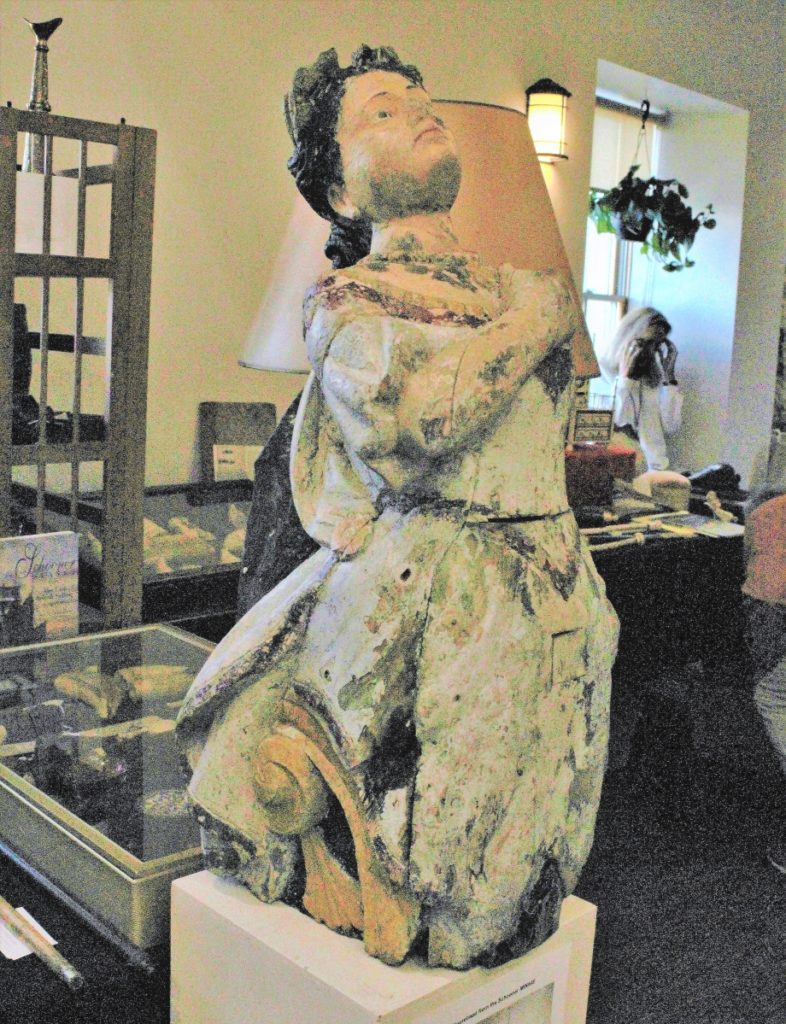
Figurehead from the Minnie, which sailed from 1878 to 1938, priced at $27,500 by Ryan M. Cooper (Yarmouth Port, Mass.).
Living artists also appeared in the show, including the scrimshander Darrel Morris from Martha’s Vineyard, Mass., who was sharing a booth with Bill Feeney of F&F Inc (Fall River, Mass.). Feeney’s tables were stacked with decorated and undecorated whales’ teeth, Inuit art, carved instruments and sculptures made from prehistoric fossilized ivory and antique, ethically sourced scrimshaw. Plastic totes of more teeth and other goods were stashed underneath the tables. Morris only had a few pieces of his own scrimshaw available at the show as he was promoting his fine art. He offered prints of his ink-on-paper drawing of an antique bottle with the label of Sperm Sewing Machine Oil by Wheeler & Wilson, circa 1875. The original is in a private collection, and Morris was selling the prints for $200 each. He plans to continue the series and decorated his part of the booth with other antique bottles of whale oil.
Andrew Jacobson, who specializes in maritime antiques and Americana out of Ipswich, Mass., was busy throughout the show’s opening, but we were able to get his attention to discuss a diminutive folk art barrel whimsey with its own stand. The piece was hand-painted with hearts and diamonds and inlaid with bone on its stand. “It has no purpose as far as I can tell,” Jacobson said. “The hearts usually meant that it was a gift for the maker’s sweetheart; maybe he had her over a barrel.” Jacobson also spoke the next day during the weekend’s seminars, giving the annual market report.
Sanford Moss of Sandy’s Tools (Westport, Mass.) already had a pile of empty packaging socks as his whale’s teeth sold. Also displayed prominently was a hand-colored print of “Thunderbirds And Whales,” published and copyrighted by “E.S. Curtis” in 1914. Edward Sherriff Curtis (American, 1868-1952) is best known for his photography and portraits of the American West and its original Indigenous inhabitants. This image was from the Pacific Northwest where both enormous creatures, one cryptid and one cetacean, are credited with equally sizable supernatural powers. Stories vary between tribes in this region, but the struggle between thunderbirds and whales are often associated with earthquakes and tsunamis.
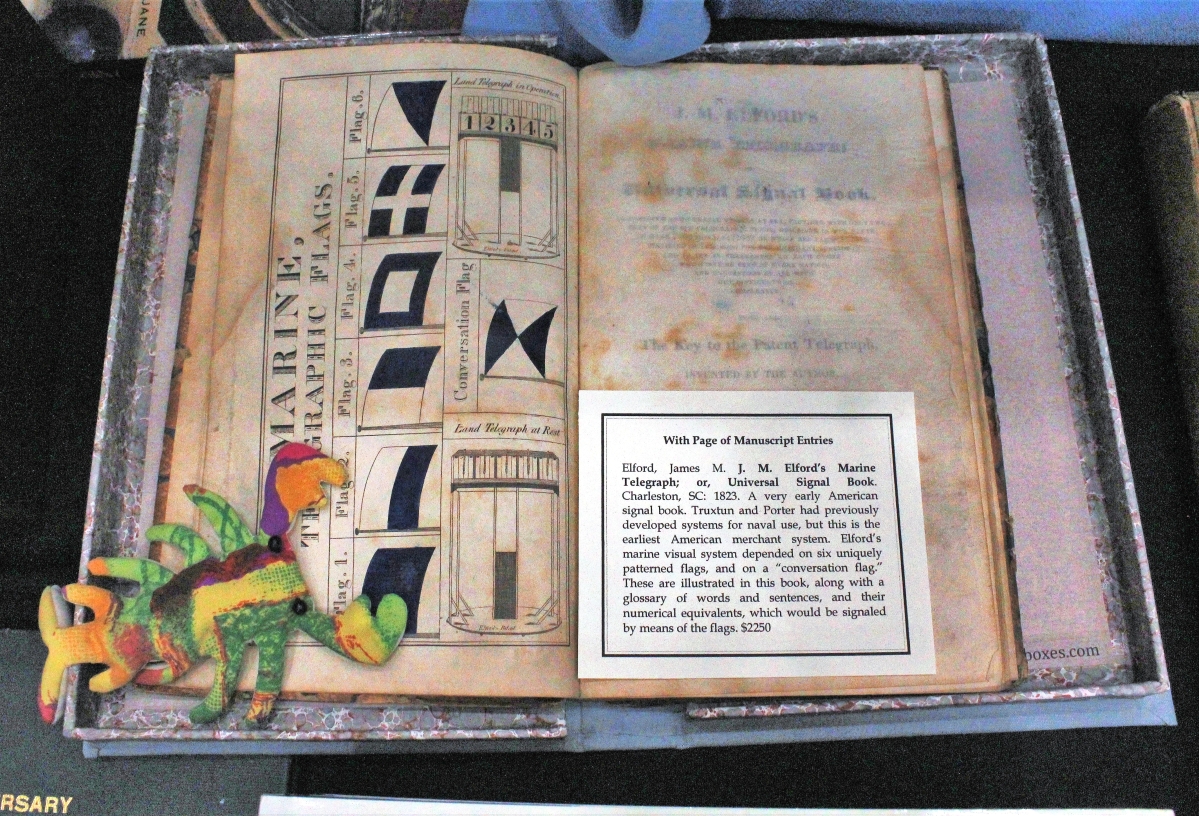
A tie-dyed lobster-shaped bean bag helped to hold the pages of this 1823 manuscript, J.M. Elford’s Marine Telegraph; or, Universal Signal Book, from Ten Pound Island Book Company (Gloucester, Mass.) priced at $2,250.
Frederick Mitchell, owner of New Bedford-based shop Whalemen’s Shipping List and father of New Bedford’s Mayor Jon Mitchell, was also offering fine art. The largest of his stock was a dynamic painting with a scene from “Moby Dick” by George Snow Hill (American, 1898-1969). The encaustic painting was in Mitchell’s own collection for about 25 years. Known as a muralist, Hill’s work appears in airports and public buildings throughout the United States and was featured in the 1939 New York World’s Fair. Many of these were lost when buildings were torn down or removed due to objections against their content. Studies for a “Moby Dick” mural survive, but it is not known if they were ever executed. The scarcity of Hill’s work adds to the value of this painting, which was priced at $5,500.
The tools of the seafaring trade were also prominently on display throughout the show, some humble in their appearance but significant in their history, and others that were just as rare and delicate as they appeared. Ken Hamilton of Corinth, Maine, is a historical consultant of the French and Indian Wars, an author and artist and metalsmith. This collection of occupations was matched by his extensive knowledge of the wares on display in his booth, including an array of fids that were arranged in their own rack. Fids are multipurpose tools traditionally made of wood or bone, used for splitting rope, holding open knots or punching holes in canvas. Many of Hamilton’s fids were crafted from lignum vitae, a slow-growing tropical wood that’s self-oiling and the densest wood available. The sweet scent of the oil was still palpable on even the oldest fids. These varied in size to match different gauges of wood, as well as price, varying from $60 to the high hundreds.
Alan Granby of Hyland Granby Antiques (Hyannis Port, Mass.) was not only selling during the weekend, but presenting on his guest-curated exhibition “Scrimshaw: The Whaler’s Art” at the Cahoon Museum on Saturday and Sunday, as well as signing copies of his book, Wandering Whalemen and their Art: A Collection of Scrimshaw Masterpieces. His booth was impressive and Granby himself was warm and inviting. The centerpiece was “Ship taking on a Pilot in Boston Harbor” by Fitz Henry Lane, showing a ship and a two-masted schooner sailing towards each other with the Massachusetts State House dome at the skyline’s vanishing point. The painting was priced at $285,000.
Planning for the ASCA’s 2023 Scrimshaw & Nautical Antiques Weekend is underway. For more information, 508-888-6434 or www.antiquescrimshaw.org.
























